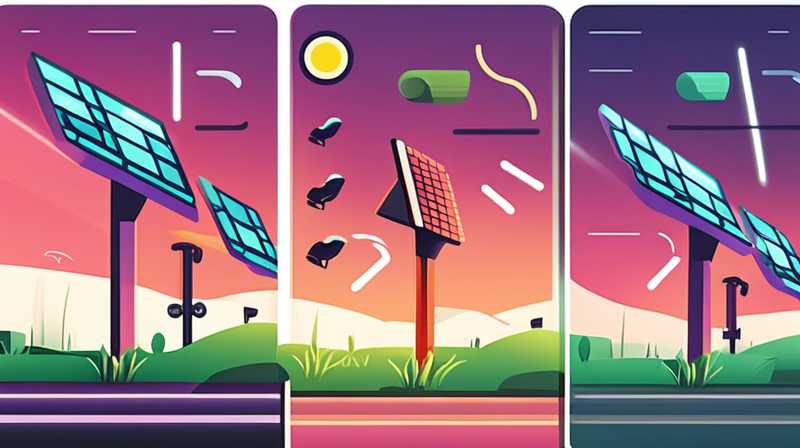
To determine the wattage of the brightest roadside solar light, 1. the power ranges can extend from 50 watts to 600 watts, making the peak performance significantly influential in comparison. 2. Factors contributing to brightness include lumens output, design efficiency, and the solar panel’s quality. 3. Cost and installation complexity may vary with the higher wattage models. 4. The application context is crucial; residential areas, highways, and commercial zones require different approaches regarding visibility and safety. Among these, the brightness measured in lumens acts as a critical indicator, with higher lumens translating to superior visibility for pedestrians and vehicles alike. This detailed examination of power classes can greatly assist in selecting the optimal lighting solution for specific outdoor environments, ensuring compliance with safety standards while enhancing public illumination.
1. UNDERSTANDING LUMENS AND WATTS
In the realm of lighting, a fundamental aspect resides in understanding the relationship between watts and lumens. Watts signify the energy consumption of a light, whereas lumens measure the visible light output. Therefore, with advancements in technology, newer models of solar lights yield more lumens for fewer watts, rendering them increasingly efficient. This shift has transformed traditional lighting paradigms, as users prioritize brightness, longevity, and economic viability.
Moreover, roadside solar lighting primarily employs LED (Light Emitting Diode) fixtures due to their low energy consumption, extended lifespan, and high luminous efficacy. An LED light can produce substantial lumens while consuming minimal watts, thereby enhancing sustainability and operational cost-effectiveness. Understanding these metrics aids users in making informed decisions, encouraging the shift toward greener technology solutions.
2. EVALUATING POWER OUTPUT OF SOLAR LIGHTS
Forecasting the power output of solar lights necessitates examining their diverse wattage variations, ranging typically from 50 to 600 watts. The greater the wattage, the higher the light output, thus enhancing visibility, particularly in environments with significant vehicular traffic. Various models bring forth different configurations of solar panels, batteries, and LEDs, creating variation in brightness and duration of illumination.
Higher wattage lights, generally around the 300 to 600 watts mark, tend to be utilized for major roads, highways, and expansive parking lots. Meanwhile, lower wattage models serve effectively in residential areas or for pedestrian walkways, retaining adequate illumination while mitigating energy waste. Therefore, evaluating the necessary brightness and context of use is paramount, permitting users to select the sufficient wattage that corresponds with their specific needs.
3. FACTORS INFLUENCING BRIGHTNESS
Several elements significantly contribute to the overall brightness and efficiency of roadside solar lights. Quality of components, such as batteries and solar panels, play a fundamental role in determining performance. Higher-quality batteries enable longer illumination times after sunset, ensuring that lights remain effective through the night.
Moreover, the angle of solar panels affects energy absorption during daylight hours. Panels that can adjust to maximize solar exposure throughout the day can lead to improved energy capture, increasing overall performance during operational hours. Thus, illuminating factors extend beyond mere wattage, necessitating a deep dive into the specifications and materials of various models.
4. COST COSIDERATIONS OF HIGH WATTAGE LIGHTS
Elevated wattage lights typically come with higher upfront costs; however, they can also afford users significant savings in the long run through reduced energy bills and minimized maintenance needs. Investing in high-performance solar lights often correlates to longer lifespans and better reliability, enhancing value over time.
Furthermore, installation costs may also escalate as additional infrastructure or professional assistance might be required for larger systems. Users must weigh these initial expenses against potential long-term savings and benefits, particularly in high-traffic or high-risk areas that may require enhanced illumination for safety purposes.
FAQs
WHAT IS THE BRIGHTNESS MEASUREMENT IN SOLAR STREET LIGHTS?
Brightness in solar street lights is measured in lumens, which quantify the amount of visible light emitted. For effective illumination, a typical solar street light needs to produce between 1,000 to 10,000 lumens depending on its location and application. For instance, highways might require higher lumens to ensure visibility for drivers, while residential streets may necessitate lower luminosity. Determining the right lumens for specific areas depends on factors such as the surrounding environment, the purpose of lighting, and safety considerations.
HOW LONG DOES A SOLAR STREET LIGHT LAST ON A FULL CHARGE?
Solar street lights generally last anywhere between 8 to 12 hours when fully charged. This duration relies on factors such as battery capacity, solar panel efficiency, and local weather conditions. In optimal conditions with full sunlight, the batteries can accumulate enough energy during the day to sustain illumination throughout the night. Some models incorporate smart technology to manage power consumption, adapting brightness based on environmental needs and ensuring optimum performance regardless of weather fluctuations.
CAN SOLAR STREET LIGHTS WORK IN CLOUDY CONDITIONS?
Yes, solar street lights can still operate effectively in cloudy conditions but may experience reduced performance compared to full sunlight. Advanced solar technology allows the panels to absorb ambient light. However, consistent cloudy or rainy weather could affect the battery charging capacity, leading to less lighting duration in the evening. Users might consider investing in systems with higher battery capacities or solar panel efficiency ratings to negate these concerns and maintain performance levels.
In closing, the brightness of roadside solar lights, measured primarily in watts and lumens, signifies a pivotal aspect of planning and implementing outdoor illumination. Understanding this balance offers critical insights into selecting the appropriate lighting solutions. Users can harness the advantages of advanced solar technologies while optimizing performance efficiency, ensuring enhanced safety and visibility in areas requiring illumination. The escalated range of wattages reflects the diverse demands of various applications, warranting careful analysis before making selections. Cost implications and long-term benefits further establish the necessity for thorough consideration in the buying process. Selecting properly engineered and adequately powered solar lights not only contributes to sustainability initiatives but also accommodates practical safety measures within urban environments. Thus, a conscientious approach ensures the alignment of user needs and environmental responsibilities, guiding the way for brighter, safer future pathways.
Original article by NenPower, If reposted, please credit the source: https://nenpower.com/blog/how-many-watts-is-the-brightest-roadside-solar-light/


